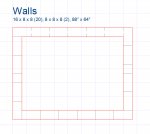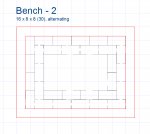Hello all,
I've been devouring this forum in to the wee hours of the night for several days now, searching for advice, and thought it was time I actually asked some questions.
I'm considering building a small soaking pool (what I'm calling a 'greek pool' because I got the idea when I saw a piscina in an ancient greek house, because I'm a nerd like that). The goal is 7' x 5' with 3' of water depth. The interior would be tiled. And there'd be some basic filtration. I don't want this to be a huge/months long project, but I also don't want to be maintaining the thing all the time. Looking for a balance between simplicity in construction and...well, I guess simplicity in maintenance.
My thinking right now is to use concrete blocks for the main construction. Sounds like I'll need to do a poured concrete floor first, then lay the concrete blocks for the walls with vertical rebar in each block. Then fill each block with concrete.
A few questions I have though:
And just generally I'm looking for any advice, experience, or opinions you guys have.
Thanks!
I've been devouring this forum in to the wee hours of the night for several days now, searching for advice, and thought it was time I actually asked some questions.
I'm considering building a small soaking pool (what I'm calling a 'greek pool' because I got the idea when I saw a piscina in an ancient greek house, because I'm a nerd like that). The goal is 7' x 5' with 3' of water depth. The interior would be tiled. And there'd be some basic filtration. I don't want this to be a huge/months long project, but I also don't want to be maintaining the thing all the time. Looking for a balance between simplicity in construction and...well, I guess simplicity in maintenance.
My thinking right now is to use concrete blocks for the main construction. Sounds like I'll need to do a poured concrete floor first, then lay the concrete blocks for the walls with vertical rebar in each block. Then fill each block with concrete.
A few questions I have though:
- Is the rebar and poured concrete in the concrete block walls necessary for a pool this size?
- Any chance I could do something other than a poured concrete floor? Perhaps use concrete blocks there too? Or would it shift too much?
- I'm building a bench around the edge of it. Was going to use cinder blocks to construct this as well. Is there a better way?
- Should I be applying some sort of sealer to the gaps and/or entire interior. And/or perhaps plastering it? I don't want ieak and I want it tiled. How do I make that happen? I've heard using epoxy thin set / grout with the tiles might be enough. If I do need to seal it, what sort of product would you recommend?
- Any tips on tile types to use/avoid? Ceramic, porcelain, etc.
- Any suggestions of type or size of filtration I'll need?
- What's the deal with saltwater clorination? Like the idea, but know very little about it. Does it make sense for a small pool?
- Dumb question, but do I need a drain? I imagine I could just siphon out the water when draining it.
And just generally I'm looking for any advice, experience, or opinions you guys have.
Thanks!



